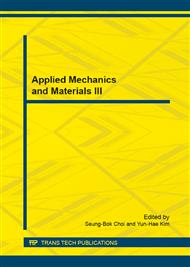[1]
J. Guo, W.Q. Liu, S. G. Wang and J. Q. Hong: Earthquake Resistant Engineering and Retrofitting. Vol. 30 (2008), p.68.
Google Scholar
[2]
Aiqun Li: Vibration Control of Engineering Structure (In Chinese). (China Machine Press, Beijing 2007).
Google Scholar
[3]
National Standard of People's Republic of China. Code for seismic design of buildings(G B50011-2010). (China Building Materials Press, Beijing 2010).
Google Scholar
[4]
Z. G. Xu, F. L. Zhou and L. Kong: Journal of South China Construction University (West Campus). Vol. 7 (1999), p.15-p.20.
Google Scholar
[5]
V. A . Matsagar, R. S. Jangid: Practice Periodical on Structural Design and Construction. (2008). (2008), p.175-p.185.
Google Scholar
[6]
A. Q. Li, L. J. Mao: Earthquake Resistant Engineering and Retrofitting (2005). Vol. 22 (2005), p.27-p.31.
Google Scholar
[7]
D. Way, J. Howard: Earthquake Spectra. Vol. 6 (1990), p.297-p.308.
Google Scholar
[8]
A. S. Mokha, N. Amin, M. C. Constantinou and V. Zayas: Journal of Structural Engineering. (1996), p.298-p.308.
Google Scholar
[9]
Y. Masuzawa, Y. Hisada: 13th World Conference on Earthquake Engineering. (2004).
Google Scholar
[10]
A. D. Luca, E. Mele, J. Molina, G. Verzeletti and A. V. Pinto: Earthquake Engineering and Structural Dynamics. Vol. 30 (2001), p.1125-p.1145.
DOI: 10.1002/eqe.54
Google Scholar
[11]
Y. Zhang, Q. Jin and J. Zhou: Earthquake Resistant Engineering and Retrofitting. Vol. 32 (2010), p.60-p.66.
Google Scholar
[12]
J. Q. Hong, W. Q. Liu, S. G. Wang and J. Guo: Earthquake Resistant Engineering and Retrofitting. Vol. 29 (2007), p.87-p.92.
Google Scholar
[13]
L. Zhang: Fujian Architecture and Construction. Vol. 135 (2005), p.37.
Google Scholar
[14]
Z. W. Pan, J. Li, H. T. Zhou and J. Jin: Building Structure. Vol. 43 (2013), p.67-p.72.
Google Scholar
[15]
X. Zhen, X. S. Fan, C. H. Hu and H. F. Li: Earthquake Resistant Engineering and Retrofitting. Vol. 31 (2009), p.64-p.69.
Google Scholar
[16]
Y. C. Huang: Building Construction. Vol. 35 (2013), p.510.
Google Scholar
[17]
Y. H. Zhu, X. J. Feng and W. D. Kou: Earthquake Resistant Engineering and Retrofitting. Vol. 34 (2012), p.75-p.81.
Google Scholar
[18]
X. S. Fan, H. Y. Xu, S. Z. Ren and W. Lv: Journal of Shangdong Jianzhu University. Vol. 25 (2010), p.255-p.258.
Google Scholar
[19]
Bingkang Liu and An Zhou: Identification and Retrofitting of Engineering Structure (In Chinese). (China Building Materials Press, Beijing 2008).
Google Scholar


